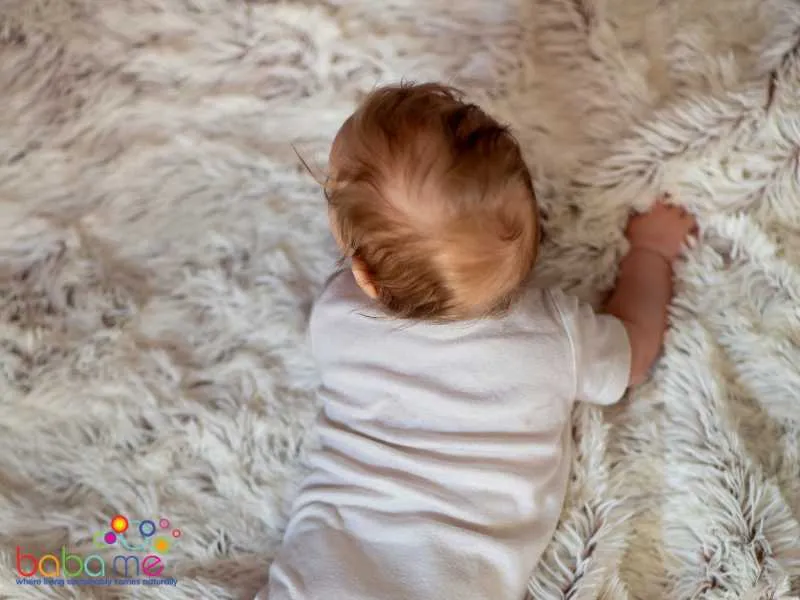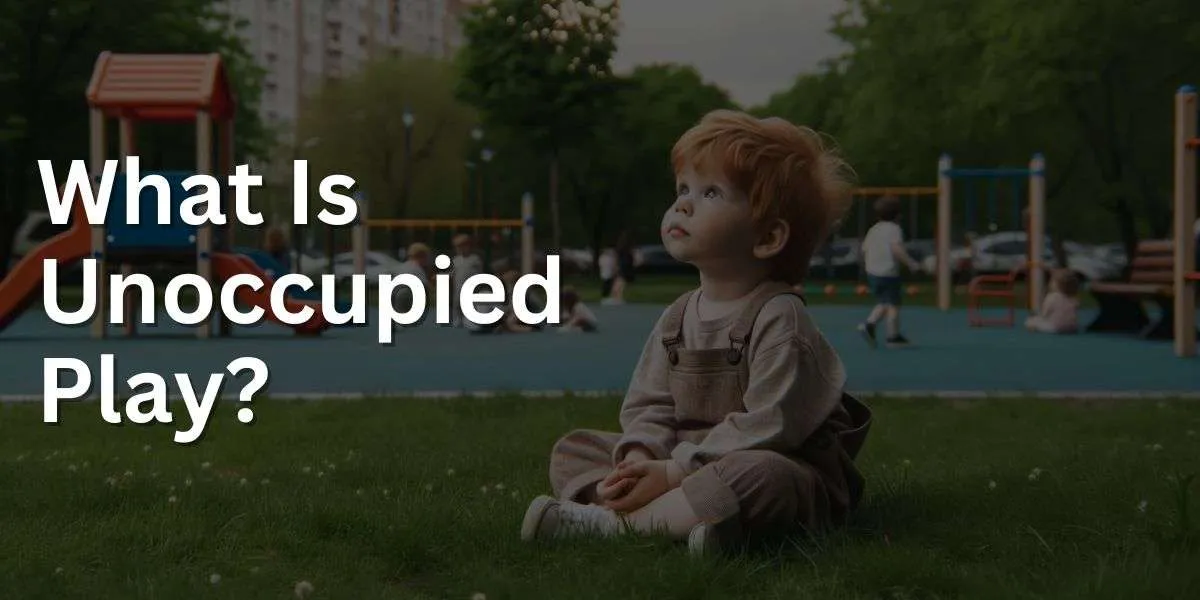Unoccupied Play is a foundational phase in the realm of early childhood development. Recognizing Unoccupied Play is essential for understanding the initial steps a child takes in their exploration of the world, as it underscores a child’s inherent curiosity and observational skills.
In the context of play, Unoccupied Play refers to moments when children, typically infants and young toddlers, appear to be aimlessly moving around without a specific purpose or engagement in their environment. However, these moments are far from insignificant:
- It signifies a child’s initial exploration where they are absorbing their surroundings, taking in sensory experiences, and processing new stimuli.
- This phase lays the groundwork for future cognitive and motor skills development, as seemingly random movements pave the way for more purposeful actions and interactions.
- It provides a glimpse into a child’s budding curiosity, giving caregivers a chance to observe their interests and preferences.
Ever wondered about the silent observations and subtle engagements of a child in their early stages? Delve into Unoccupied Play with us, as we uncover its significance and role in setting the stage for a child’s lifelong journey of discovery and learning.
Key Takeaways on What is Unoccupied Play
- Unoccupied Play is the early developmental stage where infants and young children appear to be randomly exploring their environment without a specific goal or intention in their actions.
- During this stage, children might appear to be aimlessly moving around with no clear purpose, but they are indeed familiarizing themselves with the world. Actions such as staring at their hands, watching their surroundings, or simply moving objects without any clear pattern can be observed.
- Unoccupied play sets the foundation for exploration and discovery. While the actions may seem random, children are processing a vast amount of sensory information, leading to cognitive and motor development.
- This stage is vital for sensory integration. Children are attuning themselves to different sights, sounds, textures, and sensations, paving the way for more purposeful exploration in later stages.
- The seemingly aimless activities during unoccupied play are the first steps towards building curiosity. It’s the beginning of a child’s journey in becoming an active and eager learner, excited to engage with their environment.
- As children gather more information and develop a better understanding of their surroundings through unoccupied play, they naturally progress to more directed and purposeful play stages, marking their continuous growth.
Definition of Unoccupied Play
Unoccupied play, as conceptualized in Mildred Parten’s Six Stages of Play, is the earliest form of play where the child is not engaged in any specific activity or play pattern. Instead, the child observes their surroundings and might appear to be daydreaming, wandering, or even just fiddling with their hands, feet, or objects around them.
It might seem as though the child is not playing, but they are actually exploring the world in their own way, taking in sensory experiences, and learning about their environment. It’s a foundational stage in the development of play, and even though it might not have a clear structure or purpose to adults, it’s essential for the child’s cognitive and sensory development.
During unoccupied play, children explore their immediate environment, their own bodies, and the objects around them. These explorations, while appearing directionless, are the building blocks for understanding the world. Through such engagements, young children become aware of their own existence, the effects of their actions on their surroundings, and the basic principles of cause and effect, basic cognitive skills.
Mildred Parten emphasized the significance of this stage in child development, underscoring its role in laying the groundwork for subsequent stages of play and social interaction. As children progress from unoccupied play, they gradually move to more structured and interactive forms of play, each building upon the learnings of the previous stage.

Importance of Unoccupied Play
Unoccupied play holds a pivotal role in a child’s development. At first glance, it might seem like aimless activity, but this form of play is brimming with cognitive and motor exploration. Children, primarily infants and young toddlers, engage in random movements, familiarizing themselves with their immediate environment and their own bodies.
Through these seemingly directionless engagements, children grasp the fundamental concepts of cause and effect. The subtle shifts in their surroundings, the feeling of different textures, and the sounds they produce all contribute to their burgeoning understanding of the world. This stage serves as the foundational block, preparing them for more structured and interactive play experiences in the future.
Unoccupied play, thus, is not just a passive stage; it’s an active exploration and an essential phase that shapes a child’s perception, understanding, and interaction with the world around them.
Stages and Characteristics of Unoccupied Play
Unoccupied play is part of the stages of play as defined by Parten:
| Stage of Play | Definition | Age Group | Key Benefits |
|---|---|---|---|
| Solitary Play | This stage is characterized by a child playing alone and being completely engrossed in their own activities. | Common in infants and toddlers. | Develops a child’s imagination, creativity, and sense of self. |
| Onlooker Play | This stage involves a child watching others play but not participating. | Common in preschoolers. | Children learn about different play styles and develop their own play preferences. |
| Parallel Play | In this stage, children play alongside each other but do not interact. | Common in toddlers and young children. | Helps children develop social skills, understanding of sharing and turn-taking. |
| Associative Play | This stage sees children playing together in a loosely organized way, sharing materials and ideas but without a set goal. | Common in preschoolers. | Develops children’s communication, collaboration skills, and understanding of shared goals. |
| Cooperative Play | This is a stage where children play together in a structured way towards a common goal. | Common in school-aged children. | Helps children develop problem-solving abilities, teamwork skills, and a sense of community. |
Unoccupied play represents the foundational stage in a child’s play development journey. Characterized by seemingly random and aimless movements, this form of play is most commonly observed in infants and young toddlers. While it might appear as mere fidgeting or wandering, there’s a deeper exploration at play.
The primary characteristic of unoccupied play is its lack of specific direction or purpose. Children in this stage might stare at their hands, observe objects around them, or simply move without a clear goal. However, these actions are significant. They mark the beginning of a child’s interaction with the world, providing the sensory input that fuels cognitive and motor development.
As the child progresses, unoccupied play evolves into more structured forms of engagement, each with distinct characteristics and objectives. But the importance of this initial stage cannot be understated. It sets the foundation, paving the way for complex interactions, understanding, and developmental milestones in the subsequent stages of play.
| Stage | Age | Characteristics | Examples |
|---|---|---|---|
| Early Unoccupied Play | 0-3 months | Babies observe their environment without much interaction. | Watching mobiles, listening to sounds. |
| Mid Unoccupied Play | 4-8 months | Babies begin to explore their bodies and objects around them. | Banging toys, feeling different textures. |
| Late Unoccupied Play | 9-12 months | Babies experiment with cause and effect. | Dropping toys to observe their fall, making sounds by clapping. |
| Toddler Unoccupied Play | 1-2 years | Toddlers begin to engage in solitary play, still largely unstructured and exploratory. | Playing with blocks, sorting shapes, simple pretend play. |
| Preschool Unoccupied Play | 2-3 years | Children start to engage more in parallel play and begin to understand symbolic play. | Playing side by side with peers, pretending a block is a car. |
| Pre-kindergarten Unoccupied Play | 4-5 years | Children begin associative play, engaging in similar activities as others but not necessarily together. | Building similar structures with blocks, playing house with peers |
When Does Unoccupied Play Occur
Unoccupied play typically emerges during the earliest phases of a child’s life. Predominantly observed in infants and young toddlers, this stage is characterized by a child’s exploration of their immediate environment without a defined objective or direction. During these moments, a baby might be seen gazing intently at their own hands, staring at a mobile hanging above their crib, or simply making spontaneous movements in the air.
The beauty of unoccupied play is its spontaneity. It can occur anytime the child is awake and alert, allowing them the freedom to interact with their surroundings. Whether lying in a crib, seated in a high chair, or even during short periods of tummy time, these seemingly random engagements are the child’s way of connecting with the world.
As children grow and mature, their play evolves and becomes more structured. However, those initial moments of unoccupied play are crucial, laying a foundation for cognitive and motor skills development, and fostering a natural curiosity about the world around them.

Benefits of Unoccupied Play
Unoccupied play, though seemingly aimless, holds a myriad of benefits for a child’s developmental journey. During these moments of random movements and observations, children lay the groundwork for cognitive and sensory exploration. This form of play helps hone their attention span as they focus on their hands, objects, or the environment, building the foundation for future concentration tasks.
The sensory inputs gathered during unoccupied play are invaluable. Every touch, sound, and sight is a new learning experience. This sensory exploration aids in the development of neural pathways, enhancing brain functions and processing abilities. Moreover, these seemingly random movements contribute to the growth of fine and gross motor skills, paving the way for more refined actions in the future.
Emotionally, unoccupied play offers a space for self-soothing and self-regulation. The child learns to find comfort in their own company, exploring emotions and reactions in a safe environment. This initial stage of play, often overlooked, is instrumental in shaping a child’s perception, understanding, and emotional well-being as they navigate the complexities of the world around them.
Encouraging Unoccupied Play: Tips for Parents
Promoting unoccupied play is vital for a child’s holistic development, and it’s simpler than one might imagine. One of the primary ways to encourage this kind of play is by providing a safe and stimulating environment. Setting up a comfortable space with soft textures, a variety of colors, and gentle sounds can invite infants and toddlers to explore their surroundings with curiosity.
While toys and gadgets can be educational, sometimes less is more. Reducing the number of toys available can stimulate a child’s creativity and imagination, allowing them to derive pleasure from the simplest things. For instance, the rustling of a paper, the feel of a soft blanket, or the sight of floating bubbles can be intriguing for a young mind.
Another essential element in promoting unoccupied play is giving children the freedom to explore at their own pace. Instead of directing their actions or intervening too quickly, allow them to experience and respond to their environment. Observing them from a distance, without interruption, lets them establish their own rhythms and patterns in play.
Remember that every child is unique. Their inclination towards unoccupied play might vary, and that’s perfectly okay. Being patient, flexible, and understanding of their individual needs will ensure they reap the numerous benefits this foundational stage of play offers.

FAQs on What is Unoccupied Play
What is unoccupied play in early childhood?
In early childhood, unoccupied play typically happens in the first few months of life. At this stage, children are just beginning to learn about their environment. They might spend a lot of time observing others and their surroundings, and their movements are generally random and unstructured.
What is unoccupied play and example?
Unoccupied play is a stage of play where a child is not actually playing, but is more focused on observing their environment. The child may seem to be moving randomly without a clear purpose, but they are actually learning about the world around them. An example might be a baby lying on a blanket who is kicking their legs and waving their arms without any specific toy or object in mind.
What is the difference between unoccupied play and solitary play?
Unoccupied play is generally random, with the child not engaged in playing with any specific toys or objects but rather observing their surroundings. On the other hand, solitary play is when a child plays alone with toys or objects and is engrossed in their own activities. In solitary play, the child’s activities are more focused and directed.
What is unoccupied play for 4 year olds?
By the age of four, most children have moved beyond unoccupied play and are engaged in more structured types of play, such as solitary play, onlooker play, parallel play, or cooperative play. Moments of unoccupied play may still occur, such as when a child is transitioning between activities or is unsure of what to do next. These moments can still offer opportunities as children learn from their environment.




